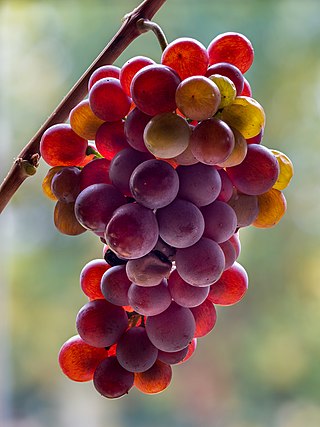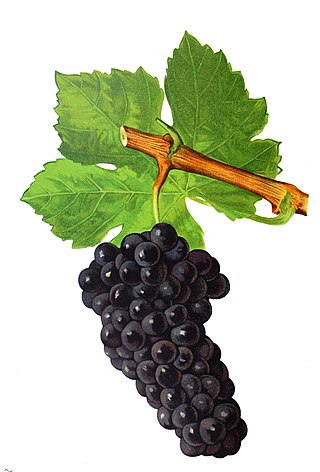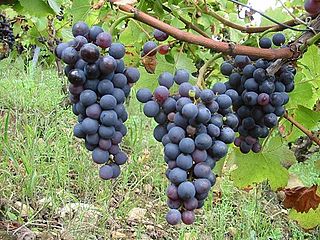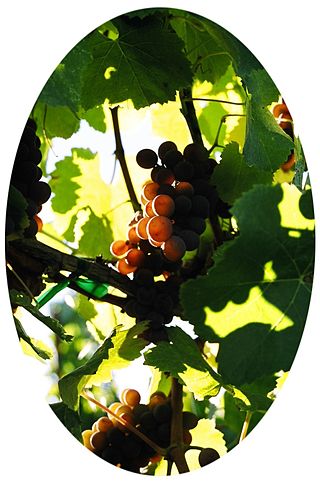
Pinot noir or Pinot nero is a red-wine grape variety of the species Vitis vinifera. The name may also refer to wines created predominantly from pinot noir grapes. The name is derived from the French words for pine and black. The word pine alludes to the grape variety having tightly clustered, pinecone–shaped bunches of fruit.

Zinfandel is a variety of black-skinned wine grape. The variety is grown in over 10 percent of California vineyards. DNA analysis has revealed that it is genetically equivalent to the Croatian grapes Crljenak Kaštelanski and Tribidrag, as well as to the Primitivo variety traditionally grown in Apulia, Italy, where it was introduced in the 18th century, and Kratošija in Montenegro. The grape found its way to the United States in the mid-19th century, where it became known by variations of a name applied to a different grape, likely "Zierfandler" from Austria.

Pinot gris, Pinot grigio or Grauburgunder is a white wine grape variety of the species Vitis vinifera. Thought to be a mutant clone of the pinot noir variety, it normally has a pinkish-gray hue, accounting for its name, but the colors can vary from blue-gray to pinkish-brown. The word pinot could have been given to it because the grapes grow in small pinecone-shaped clusters. The wines produced from this grape also vary in color from a deep golden yellow to copper and even a light shade of pink, and it is one of the more popular grapes for skin-contact wine.

Viticulture, viniculture, or winegrowing is the cultivation and harvesting of grapes. It is a branch of the science of horticulture. While the native territory of Vitis vinifera, the common grape vine, ranges from Western Europe to the Persian shores of the Caspian Sea, the vine has demonstrated high levels of adaptability to new environments, hence viticulture can be found on every continent except Antarctica.

Durif is a variety of red wine grape primarily grown in Australia, California, France, and Israel. Since the end of the 20th century, wineries located in Washington's Yakima River Valley, Maryland, Arizona, Texas, West Virginia, Chile, Mexico's Baja California Peninsula, and Ontario's Niagara Peninsula have also produced wines from Durif grapes. It is the main grape known in the U.S. and Israel as Petite Sirah, with over 90% of the California plantings labeled "Petite Sirah" being Durif grapes; the U.S. Bureau of Alcohol, Tobacco, Firearms and Explosives (ATF) recognizes "Durif" and "Petite Sirah" as synonyms for the same grape. It produces tannic wines with a spicy, plummy flavour. The grape originated as a cross of Syrah pollen germinating a Peloursin plant. On some occasions, Peloursin and Syrah vines may be called Petite Sirah, usually because the varieties are extremely difficult to distinguish in old age.

Grenache or Garnacha is one of the most widely planted red wine grape varieties in the world. It ripens late, so it needs hot, dry conditions such as those found in Spain, where the grape is believed to have originated. It is also grown in the Italian island of Sardinia, the south of France, Australia, and California's Monterey AVA, Paso Robles, Santa Barbara County and San Joaquin Valley.

Trousseau or Trousseau Noir, also known as Bastardo and Merenzao, is an old variety of red wine grape originating in eastern France. It is grown in small amounts in many parts of Western Europe; the largest plantations are today found in Portugal, where most famously it is used in port wine. It makes deep cherry red wines with high alcohol and high, sour candy acidity, and flavours of red berry fruits, often complemented - depending on production - by a jerky nose and an organic, mossy minerality.

A rosé is a type of wine that incorporates some of the color from the grape skins, but not enough to qualify it as a red wine. It may be the oldest known type of wine, as it is the most straightforward to make with the skin contact method. The pink color can range from a pale "onionskin" orange to a vivid near-purple, depending on the grape varieties used and winemaking techniques. Usually, the wine is labelled rosé in French, Portuguese, and English-speaking countries, rosado in Spanish, or rosato in Italian.

Jura wine is French wine produced in the Jura département. Located between Burgundy and Switzerland, this cool climate wine region produces wines with some similarity to Burgundy and Swiss wine. Jura wines are distinctive and unusual wines, the most famous being vin jaune, which is made by a similar process to Sherry, developing under a flor-like strain of yeast. This is made from the local Savagnin grape variety. Other grape varieties include Poulsard, Trousseau, and Chardonnay. Other wine styles found in Jura includes a vin de paille made from Chardonnay, Poulsard and Savagnin, a sparkling Crémant du Jura made from slightly unripe Chardonnay grapes, and a vin de liqueur known as Macvin du Jura made by adding marc to halt fermentation. The renowned French chemist and biologist Louis Pasteur was born and raised in the Jura region and owned a vineyard near Arbois.

Poulsard is a red French wine grape variety from the Jura wine region. The name Ploussard is used mainly around the town of Pupillin but can appear on wine labels throughout Jura as an authorized synonyms. While technically a dark-skinned noir grape, the skins of Poulsard are very thin with low amounts of color -phenols and produces very pale colored red wines, even with extended maceration and can be used to produce white wines. Because of this, Poulsard is often blended with other red-skin varieties or used to produce lightly colored rosé wines. Additionally the grape is used to make blanc de noir white wines and sparkling cremants.

Trousseau Gris is a French grape variety made into white wine. It is occasionally found in eastern France and was once widely grown in California under the name Gray Riesling. In cool climates it can produce fresh aromatic wines. It needs gentle handling and careful winemaking to bring out its best.

Agoston Haraszthy was a Hungarian American nobleman, adventurer, traveler, writer, town-builder, and pioneer winemaker in Wisconsin and California, often referred to as the "Father of California Wine", alongside Junípero Serra, as well as the "Father of California Viticulture," or the "Father of Modern Winemaking in California". One of the first men to plant vineyards in Wisconsin, he was the founder of the Buena Vista Winery in Sonoma, California, and an early writer on California wine and viticulture.

Washington wine is a wine produced from grape varieties grown in the U.S. state of Washington. Washington ranks second in the United States in the production of wine. By 2017, the state had over 55,000 acres (220 km2) of vineyards, a harvest of 229,000 short tons (208,000 t) of grapes, and exports going to over 40 countries around the world from the 940+ wineries located in the state. While there are some viticultural activities in the cooler, wetter western half of the state, the majority (99.9%) of wine grape production takes place in the shrub-steppe eastern half. The rain shadow of the Cascade Range leaves the Columbia River Basin with around 8 inches (200 mm) of annual rain fall, making irrigation and water rights of paramount interest to the Washington wine industry. Viticulture in the state is also influenced by long sunlight hours and consistent temperatures.

California wine production has a rich viticulture history since 1680 when Spanish Jesuit missionaries planted Vitis vinifera vines native to the Mediterranean region in their established missions to produce wine for religious services. In the 1770s, Spanish missionaries continued the practice under the direction of the Father Junípero Serra who planted California's first vineyard at Mission San Juan Capistrano.
Oeil de Perdrix is a rosé wine produced in Switzerland. The history of the wine style dates back to the Middle Ages in the Champagne region of France and from there spread to the Canton of Neuchâtel in Switzerland where it would become a popular dry rosé made from pinot noir. The name œil de perdrix means "partridge's eye" in French, a reference to the pale pink colour of the eye of a partridge in death throes. Until about a century ago, it was common for vineyards to have the red and white grapes unseparated unlike today where each vineyard has a unique grape. This gave white wine, red wine, and what was called grey wine because the wine was neither white nor red. It is also an old name for very pale rosé wine made not by the saignée method, but by "pressurage direct", in which the juice of red grapes is drawn off and fermented with very little contact with the skins. With the modernization of viticulture and separation of grapes, the term Oeil de Perdrix disappeared in France, but remained in the Canton of Neuchâtel in Switzerland. The Canton of Neuchâtel would export Oeil de Perdrix primarily to the German-speaking cantons of Switzerland, but also to other cantons, namely to the cantons of Geneva, Vaud, and Valais. After the Second World War, the latter decided to start producing their own Oeil de Perdrix. When the policy for wine of controlled origin (AOC) in Switzerland began, the Canton of Neuchâtel claimed the sole Oeil de Perdrix AOC, but it was refused; the cantons of Geneva, Vaud, Valais, and Neuchâtel all have the Oeil de Perdrix AOC today. The early origins of the American wine White Zinfandel can be traced to a California winemaker's attempt at making an Oeil de Perdrix–style wine.

Olmo grapes are wine and table grape varieties produced by University of California, Davis viticulturist Dr. Harold Olmo. Over the course of his nearly 50-year career, Dr. Olmo bred a wide variety of both grapes by means of both crossing varieties from the same species or creating hybrid grapes from cultivars of different Vitis species.

Cecil O. De Loach Jr. is a California grape-grower and winemaker in the Russian River Valley AVA who has contributed to the reputation and notoriety of Sonoma County viticulture.
Arpad Haraszthy was a pioneer California winemaker best known as the creator of Eclipse champagne, the first commercially successful sparkling wine produced in the state. He was the first president of the California State Board of Viticultural Commissioners, one of the founding members and first officers of San Francisco's world-famous Bohemian Club, and a frequent and articulate writer on wine, winemaking, and viticulture. He has been criticized by some modern wine historians for his claims that his father, Agoston Haraszthy, imported the first Zinfandel grape vines to California in the early 1850s. Zinfandel later became famous as California's best grape for the production of red table wine. Arpad Haraszthy's claims about his father's importations of Zinfandel have neither been proved nor disproved, and they remain a subject of controversy.
Merlot blanc is a white French wine grape variety that came from a natural crossing of the Bordeaux wine grape Merlot and the Cognac grape Folle blanche. The grape is distinct from Merlot gris which is a pink-skinned color mutation of the red wine grape Merlot and is sometimes used in vin gris and rosé wines. Plantings of Merlot blanc were first discovered in 1891 but cuttings of the vine have not been widely propagated and the variety is very rare. It is not used to make the sweet White Zinfandel-style wine White Merlot that is made by some California wine producers. Those wines are made from a saignee of red Merlot wine.














